Firearms
Under construction...
This section is dedicated to the weaponry employed by the French infantry in the Great War, 1914-1918. Please note that the majority of the images and content in this section are from http://armesfrancaises.free.fr, an excellently detailed site on French firearms.
Rifles
Sniper Scopes
Carbines
Flare Guns
Hand Guns
Machine-Guns
Bayonets
Trench Artillery
Grenade Launchers
les Fusils (Rifles):
Gras model 1874 M. 80, or model 1874/80 M. 14
Lebel model 1886 M. 93
Berthier model 1907/15 (3-round clip)
Berthier model 1907/15 M. 16, or model 1916 (5-round clip)
R.S.C. model 1917
Other rifles
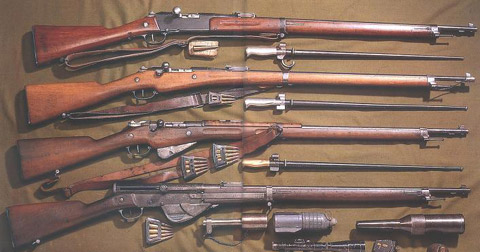
From top to bottom: Lebel m. 1886/93; Berthier m. 1907/15; Berthier m. 1907/15 M. 16; R.S.C. model 1917.
Gras model 1874 M. 80, or model 1874/80 M. 14 (11 mm)

Note: In 1914, there were a number of models of the Gras rifle still in use. These include the models 1866 M. 74, 1866/74 M. 80, 1874, 1874 M. 80, 1884 and 1885. The primary model though was the 1874 M. 80. The models 1866 M. 74 and 1866/74 M. 80 were simply refitted Chassepot model 1866 rifles, while the models 1884 and 1885 were similar to the model 1874 with minor refittings.
Basic stats:
Length: 51.6 in.
Length with bayonet: 72.2 in.
Length of barrel: 31.3 in.
Weight empty: 9.2 lbs.
Weight loaded, with bayonet: 10.4 lbs.
Class: single-shot, bolt-action
Caliber: 11 mm
Magazine: single-shot breech loader
Magazine capacity: 1 round
Ammunition: 11x59R
Primary ammunition used: model 1879/83 'M bullet' (bullet: flat-point, 25 gm, hardened lead 5.25 gm charge) or model 1879/83 'M bullet' (bullet: flat-point, 25 gm, brass-jacketed lead 3.30 gm charge)
Muzzle velocity: 450 m/s (1,476 f/s)
Initial energy: 252 kg/m (554 lbs/m)
Average rate of fire: 9 shots per min.
Practical range: 200 m (656 ft) with rear sight or non-sighted firing
Maximum effective range: 1,800 m (5,905 ft)
General Characteristics:
Sights: (Ladder) ramp rear sight (200-300 m) and vertical sight w/ sliding level (350-1800 m); triangular front sight
Safety: None
Bayonet: model 1874 sabre-bayonet
Added firepower: V.B. rifle-grenade launcher
Stamps: on the bolt-box (manufacturer and model, caliber), on the barrel (serial number, year of make)
Finishing: entirely blued save the bolt, cleaning rod, butt plate, trigger guard and trigger which are smooth polished
Arms manufacturers: Châtellerault, St.-Etienne, Tulle, Steyr in Austria (bolts and bayonets until 1877)
*Examples available in 1914: 700,000 (model 1874 M. 80 or 1866 M. 74); 120,000 (models 1878, 1884 and 1885)
Total examples produced: 2,250,000 from 1875 to 1884
Period of use: 1874 to 1940
*Most of the 820,000 Gras rifles available in 1914 went to the territorials and road-guards, and these were maintained until the end of the war. Additionally, 26,630 model 1884 and 1885 rifles were distributed to train squadrons, medical assistants, customs officers, forest rangers, and to some older reservists upon their arrival at barracks; 3,500 model 1878 rifles went to the Paris fire-fighters and to the Republican Guard; 13,000 additional Gras rifles went to the garrison at Madagascar. 146,000 model 1874 M. 80 rifles will be transformed into 8 mm rifles by replacing the original barrel with one similar to that of the Lebel. These are referred to as the model 1874/80 M. 14. This transformation program will take place from November 1914 to October 1915, when it is abruptly called off. As early as January 1915, 39,000 model 1874/80 M. 14 rifles had been sent up to the zone of the armies. In 1915, 450,000 were sent to Tsarist Russia. The remaining stocks of Gras rifles (all models) were either transformed into flare-launching guns or sold off to foreign private firms.

Detail of Gras rifle with the bolt open.

The underside of the Gras rifle showing the cleaning rod lodging.
Lebel model 1886 M. 93 (8 mm)

Basic stats:
Length: 51.5 in.
Length with bayonet: 71.9 in.
Length of barrel: 31.5 in.
Weight empty: 9.2 lbs.
Weight loaded: 9.7 lbs.
Weight loaded, with bayonet: 10.8 lbs.
Class: single-shot, bolt-action
Caliber: 8 mm
Magazine: internal tubular magazine (contained in forestock)
Magazine capacity: 8 rounds (plus 1 in the transporter and 1 in the chamber: total capacity = 10 rounds)
Ammunition: 8x50R
*Primary ammunition used: model 1886 'D bullet' (bullet: 12.8 gm, brass-tipped steel, 3 gm charge of powder)
Muzzle velocity: 701 m/s (2,300 f/s)
Initial energy: 306 kg/m (673 lbs/m)
Average rate of fire: 8-10 shots per min.
Practical range: 250 m (820 ft) with rear sight or non-sighted firing
Maximum effective range: 2,000 m (6,562 ft)
Penetration:
*The model 1886 P, which began production in 1915, was also used though primarily by snipers and in machine-guns. (9.6 gm steel core with blackened-brass jacket - muzzle velocity 840 m/s [2,756 f/s])
General Characteristics:
Sights: (Ladder) tiered rear sight (adjustable to 400-800 m) and vertical sight w/ sliding level (adjustable to 850-2000 m); rectangular front sight
Safety: None (safety position: empty chamber, 1 round in the transporter)
Bayonet: model 1886 or model 1886 M. 1915 blade-bayonet
Added firepower: V.B. rifle-grenade launcher; APX model 1916 or 1917 sniper scope
Stamps: on the bolt-box (manufacturer and model, caliber), on the barrel (serial number, year of make)
Finishing: entirely blued save the bolt, trigger guard, butt loop and butt plate
Arms manufacturers: Châtellerault, St.-Etienne, Tulle
Private manufacturers: Paris at St.-Denis
Total examples produced: 3,500,000 from 1886 to 1904
Examples available in 1914: 2,880,000 (production had stopped in 1904)
Period of use: 1886 to 1960
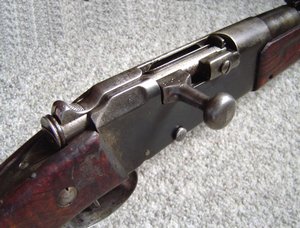
Detail of the bolt-box.

Diagram of the feeding mechanism for the Lebel, showing a round in the chamber, the transporter (empty) and 2 rounds in the magazine.
Berthier model 1907/15 (8 mm)

Basic stats:
Length: 51.4 in.
Length with bayonet: 71.9 in.
Length of barrel: 31.6 in.
Weight empty: 8.4 lbs.
Weight loaded: 8.6 lbs.
Weight loaded, with bayonet: 9.6 lbs.
Class: single-shot, bolt-action
Caliber: 8 mm
Magazine: 3-shot stripper clip
Magazine capacity: 3 rounds
Ammunition: 8x50R
Primary ammunition used: model 1886 'D bullet' (bullet: 12.8 gm, brass-tipped steel, 3 gm charge of powder)
Muzzle velocity: 701 m/s (2,300 f/s)
Initial energy: 306 kg/m (673 lbs/m)
Note: There were two variants of the Berthier model 1907/15: a 1st type with an "elbowed" bolt set at a right-angle to the stock and a 2nd type with a straight bolt. It was this 2nd type that saw distribution in the Great War.
Average rate of fire: 15-20 shots per min.
Practical range: 250 m (820 ft) with rear sight or non-sighted firing
Maximum effective range: 2,000 m (6,562 ft)
Penetration:
General Characteristics:
Sights: (Ladder) tiered rear sight (adjustable to 400-800 m) and vertical sight w/ sliding level (adjustable to 850-2300 m); rectangular front sight
Safety: None (safety position: empty chamber)
Bayonet: model 1886 M. 1915 blade-bayonet
Added firepower: V.B. rifle-grenade launcher
Stamps: on the bolt-box (manufacturer and model, caliber), on the barrel (serial number, year of make)
Finishing: entirely blued save the butt plate
Arms manufacturers: Châtellerault, St.-Etienne, Tulle, Paris (barrels)
Private manufacturers: Delaunay Belleville, Remington (9,400 examples), Contin-Souza (bolt-boxes), Avis in New York (barrels), Zavaterro (stocks), and others.
First examples produced: 1,470 in May 1915; 46,000 in August 1915
First distribution: Spring/Summer of 1916 (first to reinforcements and new replacements)
Total examples produced: 2,387,540 from 1915 to 1918
Period of use: 1916 to 1960


Detail showing the ejection window for empty stripper clips.

Detail showing the stripper clip stop in the trigger guard.
Berthier model 1907/15 M. 16 and model 1916 (8 mm)

Note: The distinction between the model 1907/15 M. 16 and the model 1916 is that the former consisted of converted model 1907 M. 15 (3-shot) rifles and the latter were those newly manufactured with the 5-shot magazine. The magazine modification did not prevent the use of 3-shot clips, thereby simplifying logistics problems.
Basic stats:
Length: 51.4 in.
Length with bayonet: 71.9 in.
Length of barrel: 31.6 in.
Weight empty: 9.2 lbs.
Weight loaded: 9.4 lbs.
Weight loaded, with bayonet: 10.4 lbs.
Class: single-shot, bolt-action
Caliber: 8 mm
*Magazine: 5-shot stripper clip
Magazine capacity: 5 rounds
Ammunition: 8x50R
Primary ammunition used: model 1886 'D bullet' (bullet: 12.8 gm, brass-tipped steel, 3 gm charge of powder)
Muzzle velocity: 701 m/s (2,300 f/s)
Initial energy: 306 kg/m (673 lbs/m)
Average rate of fire: 15-20 shots per min.
Practical range: 250 m (820 ft) with rear sight or non-sighted firing
Maximum effective range: 2,000 m (6,562 ft)
Penetration:
*Both 3-shot and 5-shot stripper clips were accepted.
General Characteristics:
Sights: (Ladder) tiered rear sight (adjustable to 400-800 m) and vertical sight w/ sliding level (adjustable to 850-2400 m); rectangular front sight
Safety: None (safety position: empty chamber)
Bayonet: model 1886 M. 1915 blade-bayonet
Added firepower: V.B. rifle-grenade launcher
Stamps: on the bolt-box (manufacturer and model, caliber), on the barrel (serial number, year of make)
Finishing: entirely blued save the butt plate
Arms manufacturers: Châtellerault, St.-Etienne, Tulle
Private manufacturers: Delaunay Belleville, Contin-Souza, Remington (9,400 examples)
First examples produced: Sept. 1916 with the design approved in Dec. 1916
First distribution: Spring of 1918
Total examples produced: Several thousand from Sept. 1916 to Nov. 1918
Period of use: 1916 to 1960
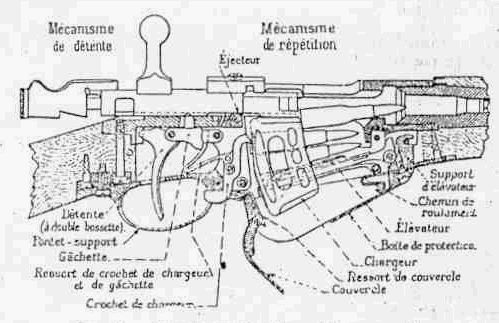
Diagram of the feeding mechanism for the Berthier, showing a round being introduced into the chamber.


Detail showing the protection box with the cover open (the empty stripper clip drops through).

Detail showing the hand-guard (put in place to protect the hand from the heat of the barrel).
R.S.C. model 1917, or F.A. 17 (8 mm)

Basic stats:
Length: 52.4 in.
Length with bayonet: 72.8 in.
Length of barrel: 31.5 in.
Weight empty: 11.6 lbs.
Weight loaded: 11.9 lbs.
Weight loaded, with bayonet: 12.5 lbs.
Class: semi-automatic, gas-operated
Caliber: 8 mm
Magazine: 5-shot stripper clip
Magazine capacity: 5 rounds
Ammunition: 8x50R
Primary ammunition used: model 1886 'D bullet' (bullet: 12.8 gm, brass-tipped steel, 3 gm charge of powder)
Muzzle velocity: 701 m/s (2,300 f/s)
Initial energy: 306 kg/m (673 lbs/m)
Note: There were three variants of the RSC (Ribeyrolle, Sutter, Chauchat) model 1917, or F.A. 17 (Fusil Automatique 17) as it was also known. The 1st type that did not have a hand-guard on the top of the barrel (see image at top of page) to protect the hand against the heat of the barrel; a 2nd type and 3rd type incorporated minor modifications to help simply production and functioning of the rifle, in particular on the bolt stop device. The rifle pictured above is the 2nd type.
Average rate of fire: 35 shots per min.
Practical range: 250 m (820 ft) with rear sight or non-sighted firing
Maximum effective range: 1,200 m (3937 ft)
Penetration:
General Characteristics:
Sights: (Ladder) tiered rear sight (adjustable to 400-800 m) and vertical sight w/ sliding level (adjustable to 850-2400 m); rectangular front sight or aperture sight with phosphorescent lozenge for nighttime firing
Safety: Hammer-locking lever
Bayonet: model 1886 M. 1915 blade-bayonet
Added firepower: None
Stamps: on the barrel (manufacturer and year of make or rebarreling); on the 3rd type only: on the bolt-box (manufacturer and model);
Finishing: entirely blued save the butt plate, blot, arming button which are smooth-polished
Arms manufacturers: Châtellerault (internal mechanisms), St.-Etienne (mobile bolt set, gas cylinder, piston, rider, barrel and firearm assemblage), Tulle (bolt-box and barrel), Paris (piston rod, elevator system, housing)
First distribution: Summer/Fall 1917 (in theory, 16 per company to the best marksman)
Total examples produced: 86,333 from April 1917 to September 1918
Period of use: 1917 to 1940

Diagram of the feeding mechanism for the R.S.C. model 1917.

Detail of the bolt-box in closed position.
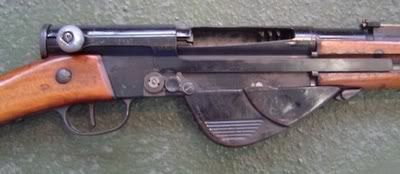
Detail of the bolt-box in open position, bolt set to the rear.
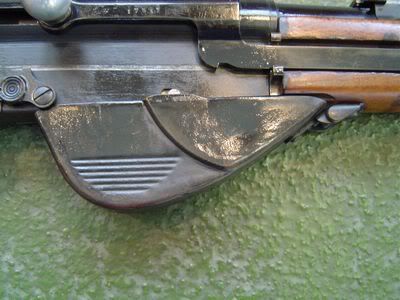
Detail of the stripper clip housing.
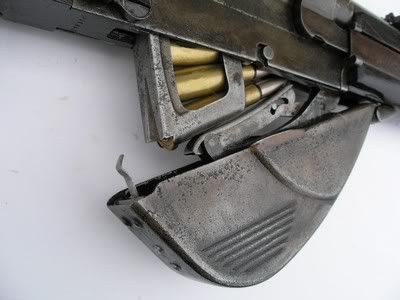
Detail of the stripper clip housing open with full clip fitted inside.
Other rifles
A number of other rifles were used from 1914-1918 by the French army. Some were pre-war productions while others were manufactured during the war. Below are some examples of these.
Gras model 1902 (11 or 8 mm)
IMAGE
The Gras model 1902 rifle was distributed mainly to Indochinese tirailleurs before the war.
Basic stats:
Length: 44.3 in.
Length with bayonet: 64.8 in.
Length of barrel: 25 in.
Weight empty: 7.9 lbs.
Class: single-shot, bolt-action
*Caliber: 11mm; or 8 mm
Magazine: 3-shot stripper clip
Magazine capacity: 3 rounds
*Ammunition: 11x59R; or 8x50R
Primary ammunition used: model 1879/83 'M bullet' (bullet: flat-point, 25 gm, hardened lead 5.25 gm charge) or model 1879/83 'M bullet' (bullet: flat-point, 25 gm, brass-jacketed lead 3.30 gm charge); model 1886 'D bullet' (bullet: 12.8 gm, brass-tipped steel, 3 gm charge of powder)
*Note: The Gras model 1902 was first set up to fire the 'M bullet' but was later modified to fire the model 'D bullet'.
Average rate of fire: 15-20 shots per min.
Practical range: 250 m (820 ft) with rear sight or non-sighted firing
Maximum effective range: 2,400 m (7,874 ft)
General Characteristics:
Sights:
1) model 'M bullet': (Ladder) ramp rear sight (200-1000 m) and vertical sight w/ sliding level (1200-2000 m); beaded front sight
2) model 'D bullet': (Ladder) tiered rear sight (adjustable to 200-1000 m) and vertical sight w/ sliding level (adjustable to 1200-2400 m); rectangular front sight
Safety: None (safety position: empty chamber)
Bayonet: Gendarme model 1866 blade-bayonet
Added firepower: None
Arms manufacturers: Châtellerault
Total examples produced: 32,800 (22,800 to Indochinese tirailleurs and 10,000 to Persian tirailleurs.
Period of use: 1902 to 1918?
Berthier model 1907 (11 or 8 mm)
IMAGE
The model 1907 rifle was distributed to Senegalese tirailleurs before the war, and is also referred to as either the 'Senegalese tirailleur rifle or the 'Colonial rifle'. Its design was based off the Lebel model 1886 but was constructed with the Mannlicher-Berthier firing mechanism.
Basic stats:
Length: 51.4 in.
Length with bayonet: 71.9 in.
Length of barrel: 31.6 in.
Weight empty: 8.4 lbs.
Weight loaded: 8.6 lbs.
Weight loaded, with bayonet: 9.6 lbs.
Class: single-shot, bolt-action
*Caliber: 11mm; or 8 mm
Magazine: 3-shot stripper clip
Magazine capacity: 3 rounds
*Ammunition: 11x59R; or 8x50R
Primary ammunition used: model 1879/83 'M bullet' (bullet: flat-point, 25 gm, hardened lead 5.25 gm charge) or model 1879/83 'M bullet' (bullet: flat-point, 25 gm, brass-jacketed lead 3.30 gm charge); model 1886 'D bullet' (bullet: 12.8 gm, brass-tipped steel, 3 gm charge of powder)
*Note: The model 1907 was first set up to fire the 'M bullet' but was later modified to fire to model 'D bullet'.
Average rate of fire: 15-20 shots per min.
Practical range: 250 m (820 ft) with rear sight or non-sighted firing
Maximum effective range: 2,000 m (6,562 ft)
General Characteristics:
Sights: 1) model 'M bullet': (Ladder) ramp rear sight (200-1000 m) and vertical sight w/ sliding level (1200-2000 m); beaded front sight
2) model 'D bullet': (Ladder) tiered rear sight (adjustable to 200-1000 m) and vertical sight w/ sliding level (adjustable to 1200-2400 m); rectangular front sight
Safety: None (safety position: empty chamber)
Bayonet: model 1907 blade-bayonet
Added firepower: None
Total examples produced: ?
Period of use: 1907 to 1918?
Meunier A-6 model 1916 (7 mm)
IMAGE
The Meunier A-6 model 1916 was an experimental semi-automatic rifle that first began development in 1905. The Meunier gained official approval in 1913 but was only put into production on a small scale as an 8 mm semi-automatic rifle was preferred.
Basic stats:
Length: 51 in.
Length with bayonet: 66.5 in.
Length of barrel: 28.2 in.
Weight empty: 8.9 lbs.
Weight loaded, with bayonet: 9.8 lbs.
Class: semi-automatic, gas-operated
Caliber: 7 mm
Magazine: 5-shot stripper clip
Magazine capacity: 5 rounds
Ammunition: 7 mm
Practical range: 250 m (820 ft) with rear sight or non-sighted firing
Maximum effective range: 2,300 m (7,546 ft)
General Characteristics:
Sights: (Ladder) ramp rear sight (300-? m) and vertical sight w/ sliding level (?-2300 m); rectangular front sight
Bayonet: derivation of model 1892 sabre-bayonet
Added firepower: None
Finishing: entirely blued save the butt plate and mobile bolt which are smooth-polished
Total examples produced: 1,013, of which 843 were sent to the army
Period of use: 1907 to 1918?
Remington Rolling-Block model 1915 (8 mm)
IMAGE
The Remington Rolling-Block model 1915 was specially made upon the request of the French army by the American firm Remington. The rifle, which was set up to fire the 8 mm round, constituted the largest single order placed by the French army during the war of a foreign-made rifle. It was distributed to rear-echelon troops, primarily the drivers, conductors, the supply train and the heavy artillery.
Basic stats:
Length: 45.4 in.
Length with bayonet: 57.4 in.; or 61.1 in.
Length of barrel: 31.3 in.
Weight empty: 9.1 lbs.
Class: single-shot, breechblock
Caliber: 8 mm
Magazine: single-shot breech loader
Magazine capacity: 1 round
Ammunition: 8x50R
Primary ammunition used: model 1886 'D bullet' (bullet: 12.8 gm, brass-tipped steel, 3 gm charge of powder)
Practical range: 250 m (820 ft) with rear sight or non-sighted firing
Maximum effective range: 2,400 m (7,874 ft)
General Characteristics:
Sights: (Ladder) ramp rear sight (200-1000 m) and vertical sight w/ sliding level (1200-2400 m); rectangular front sight
Bayonet:
Added firepower: None
Stamps: on the tang (manufacturer, date and place of make)
Total examples produced: 75,000 from 1915 to 1918
Period of use: 1915 to 1918?
Miscellaneous
Other American-made rifles ordered by the French army include:
796 Remington Rolling-Block model 1902 carbines (7 mm Mauser)
~2,400 Winchester model 1894 (.30-.30)
Remington-Lee rifles and carbines (.30-.40 Krag-Jorgensen)
By April 16, 1915, a total of 26,984 of the above varities of rifles and carbines had been shipped to France. Other foreign-made firearms ordered include:
Lee-Metford model 1888 rifles and carbines
G 88 and K 88, Mauser G 98 rifles and K 98a carbines
The firearms listed above are distributed to rear-echelon troops, primarily drivers, conductors, the supply train and the heavy artillery.






















